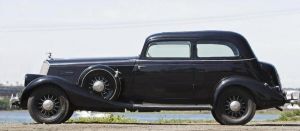- Home
- About Us
- Join/Renew
- Member Benefits
- Member Pages
- Log In
- Help
- Museum Store
Home Page › Forums › General › What would the never produced 1934 Studebaker-based P-A’s have looked like?
Happy Holidays to everyone and I hope you have a truly joyous season.
I think Studebaker’s 1934 advertising left us many clues as to what the Pierce-Arrow line might have looked like had the two companies not separated. Creation of the advertising imagery probably began in the first or second quarter of 1933 when the President and P-As were still in the business plan, and based on completed clay models. The advertising is filled with long wheelbase Presidents that Studebaker never launched, cars presented with a consistency of shape and detail that their extended proportions cannot simply be attributed to artistic embellishment. With the exception of one image, none of the imagery used for Studebaker’s 1935 advertising shows such cars.
Clues may have also been left by Pierce-Arrow itself. Did you ever wonder why the 1934 and 1935 model names affixed “40,” “45,” “48,” and “55” to the cylinder number? Were these meaningless numbers? I suspect not. Automotive names are deliberately chosen and need to be registered and protected in advance of launch. For the 1934 P-A line this was again likely done before Studebaker’s bankruptcy. I believe the numbers denoted intended wheelbases just as the 1933 line did (the 836/1236 on 139 wheelbase being an exception; perhaps the car was a late strategic addition).
Like P-A’s 1931-38 cars, the aborted 1934 wheelbases were likely derived by changing geometric elements such as door width and roof design and relative location to rear wheel. Looking at the advertising imagery, I believe the long wheelbase President and P-A’s would have used, for some models, a unique roof that was more steeply raked in the rear versus the production 1934 Studebaker roof that we are familiar with. The green car in the advertising shows this never-tooled roof. It is also shown in a 1935 brochure image of a purple Studebaker coupe, which appears to be an early rendering of the 1935 line that may well have been completed prior to bankruptcy and which the advertising agency apparently couldn’t resist using a year and a half later.
I have modified a few of the many available Studebaker images to show what the P-A versions might have looked like. In most cases I simply moved the headlights to the fender and swapped the Studebaker hood ornament for the archer. The sedans shown are what I believe would have been the mainstays of the 840/1240 series and resting on a140 inch wheelbase.
There is also advertising imagery of Studebaker’s Land Cruiser that shows elongated proportions and roofline shape quite different from what was actually produced, and example of which I have provided. I think the body style may have been developed within a few months of the 1933 Silver Arrow show car’s debut, and not in late 1933 or early 1934 as stated in the history books. More likely, the style was truncated to fit the shorter wheelbase production Studebakers at this later time.
Will attach images separately.
Aforementioned “green”” Model 840 with faster rear roof than production Studebakers. Note rear door termination well forward of short wheelbase production Studebakers.”
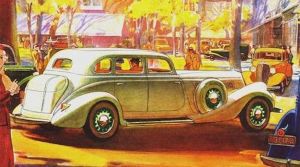
Another view of 840. On this I had to extend the hood a few inches, workign with the same front fenders, because the ad appeared to show what was likely the Model 82 President, which would have been shorter than the Model 92, as in 1933.
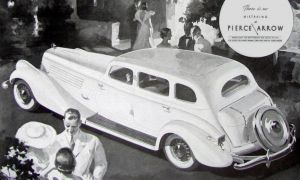
Another view of 840. Like first, only moved the headlights to the fenders and added the archer. All else is as shown in Studebaker ad.
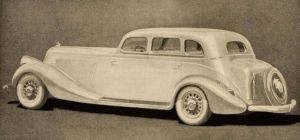
Early rendering, or clay, or image of clay of standard sedan that had been modified to show the new aerodynamic style. Note rear door’s forward location relative to rear wheels again. The car appears to be based on a Model 82 President rather than 92, neither of which were ever tooled.
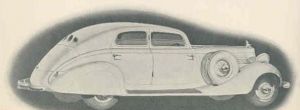
And finally, rendering of purple 1935 Studebaker coupe. Note the much faster rear than produciton. This is the image that got me thinking about the 1934 P-A line in the first place, the indispensable clue! Note that Studebaker eventually went with this faster rake for its entire 1936 line.
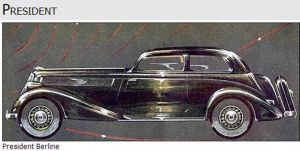
Oops, forgot one more image… the grill that never was. In descriptions of the Silver Arrow Show Car’s gestation in late 1932 there is reference made to the grill looking too much like Studebaker. The Studebaker grill being alluded to is undoubtedly the 1934 version. New car designs, even then, needed to be established a year or more prior to launch. The familiar vertical grill ultimately used for the 1934 P-A line appears to be the 1933 836 grill positioned about 1.5 inches higher off the ground, a decision born of necessity given the compressed timing that P-A found itself in as it hurried to create new bodies wholly unrelated to Studebaker.
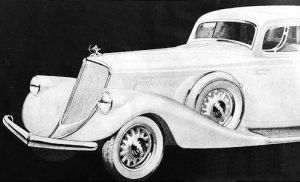
Paul, found Your 1934 P.A, Line very interesting,Being a Pierce Arrow member as well as the Studebaker club member. Thanks and Merry Christmas to All!
Paul, I have a 1936 P-A 1601 and a 1937 Studebaker President Straight
8. I have been encouraging them to mate, but it looks like you’ve
beat me to it concerning the ’34 models. Good work.
Thanks guys and glad you enjoyed it.
Found a good side view of a ’34 Studebaker that allowed for work up of several body styles. Under Erskine the company may have been planning a major offensive including something targeting the Cadillac Sixteen. Will post each separately starting with the Commander on 119 wb.
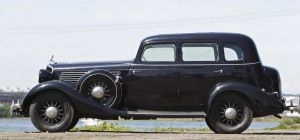
The 123 wb President was simply the Commander body with 4 inch longer front doors. The never-tooled 133 wb President would have mated the 123 wb President body to a 10 inch longer hood and the big 337 Eight. It may have been that only 9 inches were added, the 10th inch reserved for Pierce-Arrow as in 1933.
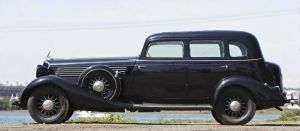
Model 833. Would such an entry Pierce have been offered? Given the stubborn Depression, quite possibly. But optimism was running high in South Bend, an economic turn-around believed to be just around the bend, so perhaps not. Were the car to have been produced, might have been made by Studebaker, priced in the low to mid-$2,000’s.
Not shown in the image is the extensive two-tone molding that Pierce would likely have used along the beltline and around the doors in place of Studebaker’s chrome trim.

Model 840 Sedan with 12 degree faster rake. This is the body style shown in most of the advertising above. Rear doors are same as 833. To maintain rear headroom and legroom the rear wheels move back 7 inches. It’s easy math: 133 wb + 7 = 140 wb. Like other manufacturers, Studebaker and Pierce built up their model range like an erector set, changing only a few elements to get from one model to the next.
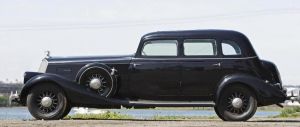
Model 840 Club Sedan. I think this variation was more likely given the previous year’s successful version. C-pillar is now blanked in, all else the same as 840 Sedan. It may have been that Studebaker alone offered the 6-window style and Pierce the 4-window.
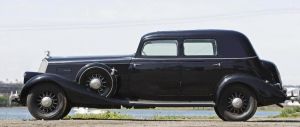
Model 845 5/7 Passenger car uses 840 as basis, adds 5 inch longer front doors from Studebaker’s 2 door models and uses 833’s upright rear roof. Division window optional. Perhaps blanked in C-pillar optional as Formal Sedan. Likely that all cars except 833 would have been offered with V12 too.
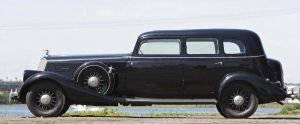
Model 1248 7 Passenger starts with 845, adds 3 inches to rear doors. No Eight offered though would probably been made at individual request. The +5 front, + 3 rear door strategy is exacly what Pierce used for its production models from 1934-38. They also used the same roof strategy, the standard sedan being upright, the club sedan more steeply raked.
Have removed the bustle trunk on this version, a variation on the body style available from the least expensive Studebaker on up. Shown as Formal Sedan.
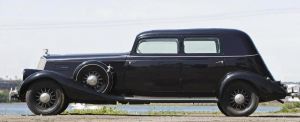
Model 1255 7-Passenger. This is the car that would take on the Sixteen. As I mentioned earlier, one inch meant a lot to Pierce. In this case it would have been one more than the 154 wb Cadillac! Such would have been the value of bragging rights.
The car is simply the 1248 with the more steeply raked rear, again adding 7 inches to the wheelbase to maintain same rear head/legroom. Note that the rear doors, which are same width as the 1248, are now 7 inches further forward of the rear fenders. Piece of cake for Pierce, especially with a run not likely to exceed 50 cars. Would have dazzled with rear mount, long and elegant.
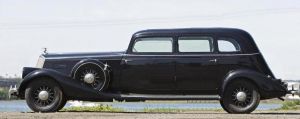
Might as well throw in the 833 2/4 Passenger coupe, also available as convertible. Created this image some time ago and didn’t bother to make the hood Pierce-like, but you get the idea.
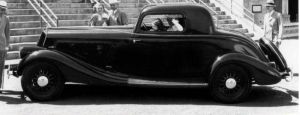
Made a mistake in earlier post on 1248. Attached is the version that would have had same rear head and legroom as more steeply raked 1255. Clearly the Formal Sedan style applied to this upright roof version is not a very flattering look, best avoided.
Also forgot to add the mainstay of the 840 line, the 6-window sedan with upright roof.
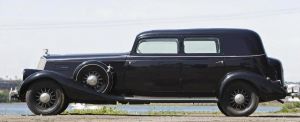
Almost forgot the Club Brougham, Model 833. This is the clone of the St. Regis; i.e. purple car.
Note that Studebaker did not offer a St. Regis on the President 123 wb. This is because that 4 inch longer wheelbase depended on the more steeply raked rear roof to look “right.” With the lwb President line cancelled due to bankruptcy and with it, the more steeply raked roof, Studebaker had to use the more upright roof as basis for St. Regis, which only looked acceptable on the shorter wheelbase Commander.
